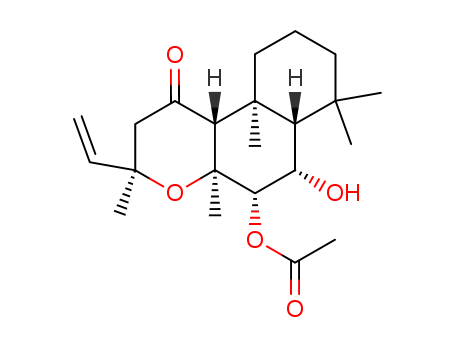Technology Process of 1,9-Dideoxyforskolin
There total 13 articles about 1,9-Dideoxyforskolin which
guide to synthetic route it.
The literature collected by LookChem mainly comes from the sharing of users and the free literature resources found by Internet computing technology. We keep the original model of the professional version of literature to make it easier and faster for users to retrieve and use. At the same time, we analyze and calculate the most feasible synthesis route with the highest yield for your reference as below:
synthetic route:
-
![(1S,7S,9S,3R,5R,8R,14R)-14-acetyloxy-8,9-dihydroxy-1,5,7,11,11-pentamethyl-6-oxa-5-vinyltricyclo[8.4.0.0<sup>2,7</sup>]tetradec-3-yl acetate](/Databaselist/images/loading.webp)
-
157201-96-2
(1S,7S,9S,3R,5R,8R,14R)-14-acetyloxy-8,9-dihydroxy-1,5,7,11,11-pentamethyl-6-oxa-5-vinyltricyclo[8.4.0.02,7]tetradec-3-yl acetate
- Guidance literature:
-
Multi-step reaction with 7 steps
1: 93 percent / p-toluenesulfonic acid / 24 h / 50 °C
2: 96 percent / lithium aluminumhydride / diethyl ether / 2.5 h / 20 °C
3: 89 percent / pyridinium chlorochromate; sodium acetate / CH2Cl2 / 3 h / 20 °C
4: 82 percent / (dimethylamino)pyridine / diethyl ether / 2.5 h / 50 °C
5: 86 percent / tributyltinhydride; azobisisobutyronitrile / toluene / 0.25 h / 100 °C
6: 100 percent / perchloric acid / tetrahydrofuran / 109 h / 20 °C
7: 86 percent / (dimethylamino)pyridine / pyridine / 1 h / 0 °C
With
dmap; lithium aluminium tetrahydride; perchloric acid; 2,2'-azobis(isobutyronitrile); tri-n-butyl-tin hydride; sodium acetate; toluene-4-sulfonic acid; pyridinium chlorochromate;
In
tetrahydrofuran; pyridine; diethyl ether; dichloromethane; toluene;
DOI:10.1021/jo060477e
- Guidance literature:
-
Multi-step reaction with 8 steps
1: 100 percent / potassium hydroxide / methanol / 13.5 h / 20 °C
2: 93 percent / p-toluenesulfonic acid / 24 h / 50 °C
3: 96 percent / lithium aluminumhydride / diethyl ether / 2.5 h / 20 °C
4: 89 percent / pyridinium chlorochromate; sodium acetate / CH2Cl2 / 3 h / 20 °C
5: 82 percent / (dimethylamino)pyridine / diethyl ether / 2.5 h / 50 °C
6: 86 percent / tributyltinhydride; azobisisobutyronitrile / toluene / 0.25 h / 100 °C
7: 100 percent / perchloric acid / tetrahydrofuran / 109 h / 20 °C
8: 86 percent / (dimethylamino)pyridine / pyridine / 1 h / 0 °C
With
dmap; potassium hydroxide; lithium aluminium tetrahydride; perchloric acid; 2,2'-azobis(isobutyronitrile); tri-n-butyl-tin hydride; sodium acetate; toluene-4-sulfonic acid; pyridinium chlorochromate;
In
tetrahydrofuran; pyridine; methanol; diethyl ether; dichloromethane; toluene;
DOI:10.1021/jo060477e






